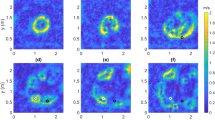Abstract
This paper presents the development of a thin filament pyrometry method to characterize the time-varying temperature field in a medium-scale pool fire burning in a quiescent environment. A digital camera with optical filters and zoom lens was used to record the high temperature emission intensity of 14 µm diameter, silicon-carbide filaments oriented horizontally at various heights above the center of a steadily burning 0.30 m diameter methyl alcohol (methanol; CH3OH) pool fire. Experiments collected 30 Hz video of the planar filament array. In a separate experiment, a 50 µm diameter thermocouple was used to acquire independent temperature measurements in the high temperature zone of the fire. A correlation was developed between the probability density functions of the radiation-corrected thermocouple measurements and the camera grayscale pixel intensity of the filaments. This arrangement enables measurement of the time-varying temperature field over a temperature range from about 1150 K to 1900 K with a spatial resolution of 160 µm, a temporal resolution of 0.033 s, and an expanded uncertainty of about 150 K (at a mean temperature of 1300 K). Measurements of the grayscale pixel intensities of the filaments were obtained. False color maps of the temperature field were produced to characterize the high temperature field as a function of time. Using statistical analysis, the local time-averaged temperatures and their variance for each location on the filaments were determined. Time-averaged temperatures were compared favorably to previously reported measurements. The dominant frequency of the puffing fire was determined. The temperature field time series was transformed to consider its character during consecutive phases of the fire’s puffing cycle. The analysis emphasizes the cyclic nature of a pool fire, providing insight on its complex dynamic structure.






















Similar content being viewed by others
Notes
Unless otherwise noted, the uncertainty in this paper is expressed as the combined uncertainty with a coverage factor of two, representing a 95% confidence interval.
Certain commercial entities, equipment, or materials may be identified in this document in order to describe an experimental procedure or concept adequately. Such identification is not intended to imply recommendation or endorsement by the National Institute of Standards and Technology, nor is it intended to imply that the entities, materials, or equipment are necessarily the best available for the purpose.
The word phase is applied as commonly used, referring to an instance in time on a cyclic waveform.
References
Cetegen BM, Ahmed T (1993) Experiments on the periodic instability of buoyant plumes and pool fires. Combust Flame 93:157–184
Peacock RD, Reneke PA, Forney GP (2013) CFAST—consolidated model of fire growth and smoke transport (Version 6), NIST Special Publication 1041r1. https://doi.org/10.6028/NIST.SP.1041r1v
McGrattan K, McDermott R, Hostikka S, Floyd J, Weinschenk C, Overholt K (2016) Fire dynamics simulator. National Institute of Standards and Technology, Gaithersburg, NIST Special Publication 1019, 6th edn. https://dx.doi.org/10.6028/NIST.SP.1019
Hamins A, Johnsson E, Donnelly M (2008) Energy balance in a large compartment fire. Fire Saf J 43:180–188
Hariharan SB, Sluder ET, Gollner MJ, Oran ES (2019) Thermal structure of the blue whirl. Proc Combust Inst 37:4285–4293. https://doi.org/10.1016/j.proci.2018.05.115
Hariharan SB (2017) The structure of the blue whirl: a soot-free reacting vortex phenomenon, Master’s Thesis, University of Maryland at College Park
Pitts WM (1996) Thin filament pyrometry in flickering diffusion flames. In: Proceedings of the twenty-sixth symposium (international) on combustion. The Combustion Institute, pp 1171–1179. https://ws680.nist.gov/publication/get_pdf.cfm?pub_id=911805
Weckman EJ, Strong AB (1996) Experimental investigation of the turbulence structure of medium-scale methanol pool fires. Combust Flame 105:245–266
Hamins A, Lock A (2016) The structure of a moderate-scale methanol pool fire, NIST Technical Note 1928. https://doi.org/10.6028/NIST.TN.1928
Kim SC, Lee KY, Hamins A (2019) Energy balance in medium-scale methanol, ethanol and acetone pool fires. Fire Saf J 107:44–53. https://doi.org/10.1016/j.firesaf.2019.01.004
Hamins A, Klassen M, Gore J, Fischer S, Kashiwagi T (1993) Heat feedback to the fuel surface in pool fires. Combust Sci Technol 97:37–62
Klassen M, Gore JP (1994) Structure and radiation properties of pool fires, NIST Report GCR-94-651, National Institute of Standards and Technology, Gaithersburg
Buch R, Hamins A, Konishi K, Mattingly D, Kashiwagi T (1997) Radiative emission fraction of pool fires burning silicone fluids. Combust Flame 108:118–126
Corlett RC, Fu TM (1966) Some recent experiments with pool fires. Pyrodynamics 1:253–269
OMEGA, Thermocouple response time. Website consulted https://www.omega.com/techref/ThermocoupleResponseTime.html. Accessed 7/1/2018
Reotemp Instruments, Type S thermocouples. Website consulted http://www.thermocoupleinfo.com/type-s-thermocouple.htm. Accessed 7/1/2018
Bergman TL, Lavine AS, Incropera FP, DeWitt DP (2011) Fundamentals of heat and mass transfer, 7th edn. Wiley, New York
Ichikawa H (2006) Advances in SiC fibers for high temperature applications. Adv Sci Technol 50:17–23. https://doi.org/10.4028/www.scientific.net/ast.50.17
Maun JD, Sunderland PB, Urban DL (2007) Thin-filament pyrometry with a digital still camera. Appl Opt 46:483–488
Bedat B, Giovanni A, Pauzin S (1994) Thin filament infrared pyrometry: instantaneous temperature profile measurements in a weakly turbulent hydrocarbon premixed flame. Exp Fluids 17:397–404. https://doi.org/10.1007/BF01877042
Mathworks Documentation: rgb2gray. Website consulted https://www.mathworks.com/help/matlab/ref/rgb2gray.html. Accessed 7/1/2018
Weckman EJ, Sobesiak A (1988) Proceedings of the twenty-second symposium (international) on combustion. The Combustion Institute, p 1299
Hamins A, Yang JC, Kashiwagi T (1992) An experimental investigation of the pulsation frequency of flames. In: Proceedings of the twenty-fourth symposium (international) on combustion. The Combustion Institute, pp 1695–1702
Petty MD (2013) Advanced topics in calculating and using confidence intervals for model validation. Spring Simul Interoper Workshop 2013:194–204
Acknowledgements
Many thanks are due to Michael Gollner and Peter Sunderland of the University of Maryland at College Park and Howard Baum of NIST for helpful discussions. The authors are grateful to Nippon Carbon Co and Hugh Spilker of COI Ceramics for providing the SiC filament samples.
Author information
Authors and Affiliations
Corresponding author
Additional information
Publisher's Note
Springer Nature remains neutral with regard to jurisdictional claims in published maps and institutional affiliations.
Rights and permissions
About this article
Cite this article
Wang, Z., Tam, W.C., Chen, J. et al. Thin Filament Pyrometry Field Measurements in a Medium-Scale Pool Fire. Fire Technol 56, 837–861 (2020). https://doi.org/10.1007/s10694-019-00906-9
Received:
Accepted:
Published:
Issue Date:
DOI: https://doi.org/10.1007/s10694-019-00906-9




